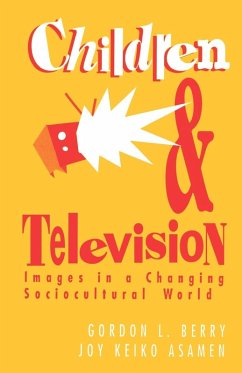Gordon L. Berry / Joy Keiko Asamen (eds.)Images in a Changing Socio-Cultural World
Children and Television
Images in a Changing Socio-Cultural World
Herausgeber: Berry, Gordon L.; Asamen, Joy Keiko; Asamen, Joy K.
Gordon L. Berry / Joy Keiko Asamen (eds.)Images in a Changing Socio-Cultural World
Children and Television
Images in a Changing Socio-Cultural World
Herausgeber: Berry, Gordon L.; Asamen, Joy Keiko; Asamen, Joy K.
- Broschiertes Buch
- Merkliste
- Auf die Merkliste
- Bewerten Bewerten
- Teilen
- Produkt teilen
- Produkterinnerung
- Produkterinnerung
The main focus of this book is to identify the social and cultural impact of television on the psychosocial development of children growing up in a constantly changing multicultural society. The book analyzes major media organizations and projects policies, practices and research directions for the future.
Andere Kunden interessierten sich auch für
![Television and the Public Sphere Television and the Public Sphere]() Peter DahlgrenTelevision and the Public Sphere71,99 €
Peter DahlgrenTelevision and the Public Sphere71,99 €![Television and Children Television and Children]() Brian R. CliffordTelevision and Children41,99 €
Brian R. CliffordTelevision and Children41,99 €![Television Families Television Families]() William DouglasTelevision Families56,99 €
William DouglasTelevision Families56,99 €![Television ',Critical Viewing Skills', Education Television ',Critical Viewing Skills', Education]() James A. BrownTelevision ',Critical Viewing Skills', Education82,99 €
James A. BrownTelevision ',Critical Viewing Skills', Education82,99 €![National Television Violence Study National Television Violence Study]() National Television Violence StudyNational Television Violence Study147,99 €
National Television Violence StudyNational Television Violence Study147,99 €![Television and Child Development Television and Child Development]() Judith Van EvraTelevision and Child Development54,99 €
Judith Van EvraTelevision and Child Development54,99 €![Television and Radio Announcing Television and Radio Announcing]() Arthur Wells GilmoreTelevision and Radio Announcing24,99 €
Arthur Wells GilmoreTelevision and Radio Announcing24,99 €-
-
-
The main focus of this book is to identify the social and cultural impact of television on the psychosocial development of children growing up in a constantly changing multicultural society. The book analyzes major media organizations and projects policies, practices and research directions for the future.
Hinweis: Dieser Artikel kann nur an eine deutsche Lieferadresse ausgeliefert werden.
Hinweis: Dieser Artikel kann nur an eine deutsche Lieferadresse ausgeliefert werden.
Produktdetails
- Produktdetails
- Verlag: Sage Publications
- Seitenzahl: 344
- Erscheinungstermin: 1. Mai 1993
- Englisch
- Abmessung: 216mm x 140mm x 20mm
- Gewicht: 486g
- ISBN-13: 9780803947009
- ISBN-10: 0803947003
- Artikelnr.: 21220956
- Herstellerkennzeichnung
- Libri GmbH
- Europaallee 1
- 36244 Bad Hersfeld
- gpsr@libri.de
- Verlag: Sage Publications
- Seitenzahl: 344
- Erscheinungstermin: 1. Mai 1993
- Englisch
- Abmessung: 216mm x 140mm x 20mm
- Gewicht: 486g
- ISBN-13: 9780803947009
- ISBN-10: 0803947003
- Artikelnr.: 21220956
- Herstellerkennzeichnung
- Libri GmbH
- Europaallee 1
- 36244 Bad Hersfeld
- gpsr@libri.de
Dr. Asamen received her doctorate in educational psychology, specializing in counseling psychology. She came to Pepperdine University after five years in psychiatric research at the Veterans Administration Medical Center in Brentwood and the UCLA Neuropsychiatric Institute. Her teaching interests are in areas of research methods and data analysis. She is a licensed psychologist in California.
Introduction - Gordon L Berry Television as a Worldwide Cultural Tapestry PART ONE: TELEVISION AND THE DEVELOPING CHILD IN A MULTIMEDIA WORLD The Developing Child in a Multimedia Society - John P Murray Cognitive Developmental Influences on Children
s Understanding of Television - Catherine N Doubleday and Kristin L Droege From Television Forms to Genre Schemata - Marguerite Fitch, Aletha C Huston and John C Wright Children
s Perceptions of Television Reality The Program-Length Commercial - Patricia Marks Greenfield et al A Study of the Effects of Television/Toy Tie-Ins on Imaginative Play Creativity of Children in a Television World - Dorothy G Singer Children and Media in Media Education - James A Anderson and Milton E Ploghoft The Medium of Television and the School Curriculum - Gordon L Berry Turning Research into Classroom Practice PART TWO: TELEVISION AND THE DEVELOPMENT OF A CHILD
S WORLDVIEW The Medium and the Society - George Comstock The Role of Television in American Life Cultural Diversity on Saturday Morning Television - Bradley S Greenberg and Jeffrey E Brand Rubik
s Tube - Edward L Palmer, K Taylor Smith and Kim S Strawser Developing a Child
s Television Worldview Conceptual Models of an African-American Belief System - Richard L Allen A Program of Research PART THREE: TELEVISION AND THE DEVELOPMENT OF A CHILD
S UNDERSTANDING OF DIVERSE POPULATIONS Television, the Portrayal of African Americans, and the Development of Children
s Attitudes - Sherryl Browne Graves Developing Television for American Indian and Alaska Native Children in the Late 20th Century - Haney Geiogamah (Kiowa) and D Michael Pavel (Skokomish) They
re So Cute When They
re Young - Darrell Y Hamamoto The Asian-American Child on Television The Television Worlds of Latino Children - Federico A Subervi-Vélez and Susan Colsant Television, the Portrayal of Women, and Children
s Attitudes - Nancy Signorielli Television, the Portrayal of the Elderly, and Children
s Attitudes - Peter M Kovaric Changing Channels - Elaine Makas The Portrayal of People with Disabilities on Television PART FOUR: FUTURE PERSPECTIVES ON PROGRAMS FOR CHILDREN Policy and the Future of Children
s Television - Dale Kunkel Public Television Programming and the Changing Cultural Landscape - Gordon L Berry The Challenge to Improve Television for Children - Horst Stipp A New Perspective The Nickelodeon Experience - Geraldine Laybourne Epilogue - Joy Keiko Asamen What Children Learn from Television and How They Learn It
s Understanding of Television - Catherine N Doubleday and Kristin L Droege From Television Forms to Genre Schemata - Marguerite Fitch, Aletha C Huston and John C Wright Children
s Perceptions of Television Reality The Program-Length Commercial - Patricia Marks Greenfield et al A Study of the Effects of Television/Toy Tie-Ins on Imaginative Play Creativity of Children in a Television World - Dorothy G Singer Children and Media in Media Education - James A Anderson and Milton E Ploghoft The Medium of Television and the School Curriculum - Gordon L Berry Turning Research into Classroom Practice PART TWO: TELEVISION AND THE DEVELOPMENT OF A CHILD
S WORLDVIEW The Medium and the Society - George Comstock The Role of Television in American Life Cultural Diversity on Saturday Morning Television - Bradley S Greenberg and Jeffrey E Brand Rubik
s Tube - Edward L Palmer, K Taylor Smith and Kim S Strawser Developing a Child
s Television Worldview Conceptual Models of an African-American Belief System - Richard L Allen A Program of Research PART THREE: TELEVISION AND THE DEVELOPMENT OF A CHILD
S UNDERSTANDING OF DIVERSE POPULATIONS Television, the Portrayal of African Americans, and the Development of Children
s Attitudes - Sherryl Browne Graves Developing Television for American Indian and Alaska Native Children in the Late 20th Century - Haney Geiogamah (Kiowa) and D Michael Pavel (Skokomish) They
re So Cute When They
re Young - Darrell Y Hamamoto The Asian-American Child on Television The Television Worlds of Latino Children - Federico A Subervi-Vélez and Susan Colsant Television, the Portrayal of Women, and Children
s Attitudes - Nancy Signorielli Television, the Portrayal of the Elderly, and Children
s Attitudes - Peter M Kovaric Changing Channels - Elaine Makas The Portrayal of People with Disabilities on Television PART FOUR: FUTURE PERSPECTIVES ON PROGRAMS FOR CHILDREN Policy and the Future of Children
s Television - Dale Kunkel Public Television Programming and the Changing Cultural Landscape - Gordon L Berry The Challenge to Improve Television for Children - Horst Stipp A New Perspective The Nickelodeon Experience - Geraldine Laybourne Epilogue - Joy Keiko Asamen What Children Learn from Television and How They Learn It
Introduction - Gordon L Berry Television as a Worldwide Cultural Tapestry PART ONE: TELEVISION AND THE DEVELOPING CHILD IN A MULTIMEDIA WORLD The Developing Child in a Multimedia Society - John P Murray Cognitive Developmental Influences on Children
s Understanding of Television - Catherine N Doubleday and Kristin L Droege From Television Forms to Genre Schemata - Marguerite Fitch, Aletha C Huston and John C Wright Children
s Perceptions of Television Reality The Program-Length Commercial - Patricia Marks Greenfield et al A Study of the Effects of Television/Toy Tie-Ins on Imaginative Play Creativity of Children in a Television World - Dorothy G Singer Children and Media in Media Education - James A Anderson and Milton E Ploghoft The Medium of Television and the School Curriculum - Gordon L Berry Turning Research into Classroom Practice PART TWO: TELEVISION AND THE DEVELOPMENT OF A CHILD
S WORLDVIEW The Medium and the Society - George Comstock The Role of Television in American Life Cultural Diversity on Saturday Morning Television - Bradley S Greenberg and Jeffrey E Brand Rubik
s Tube - Edward L Palmer, K Taylor Smith and Kim S Strawser Developing a Child
s Television Worldview Conceptual Models of an African-American Belief System - Richard L Allen A Program of Research PART THREE: TELEVISION AND THE DEVELOPMENT OF A CHILD
S UNDERSTANDING OF DIVERSE POPULATIONS Television, the Portrayal of African Americans, and the Development of Children
s Attitudes - Sherryl Browne Graves Developing Television for American Indian and Alaska Native Children in the Late 20th Century - Haney Geiogamah (Kiowa) and D Michael Pavel (Skokomish) They
re So Cute When They
re Young - Darrell Y Hamamoto The Asian-American Child on Television The Television Worlds of Latino Children - Federico A Subervi-Vélez and Susan Colsant Television, the Portrayal of Women, and Children
s Attitudes - Nancy Signorielli Television, the Portrayal of the Elderly, and Children
s Attitudes - Peter M Kovaric Changing Channels - Elaine Makas The Portrayal of People with Disabilities on Television PART FOUR: FUTURE PERSPECTIVES ON PROGRAMS FOR CHILDREN Policy and the Future of Children
s Television - Dale Kunkel Public Television Programming and the Changing Cultural Landscape - Gordon L Berry The Challenge to Improve Television for Children - Horst Stipp A New Perspective The Nickelodeon Experience - Geraldine Laybourne Epilogue - Joy Keiko Asamen What Children Learn from Television and How They Learn It
s Understanding of Television - Catherine N Doubleday and Kristin L Droege From Television Forms to Genre Schemata - Marguerite Fitch, Aletha C Huston and John C Wright Children
s Perceptions of Television Reality The Program-Length Commercial - Patricia Marks Greenfield et al A Study of the Effects of Television/Toy Tie-Ins on Imaginative Play Creativity of Children in a Television World - Dorothy G Singer Children and Media in Media Education - James A Anderson and Milton E Ploghoft The Medium of Television and the School Curriculum - Gordon L Berry Turning Research into Classroom Practice PART TWO: TELEVISION AND THE DEVELOPMENT OF A CHILD
S WORLDVIEW The Medium and the Society - George Comstock The Role of Television in American Life Cultural Diversity on Saturday Morning Television - Bradley S Greenberg and Jeffrey E Brand Rubik
s Tube - Edward L Palmer, K Taylor Smith and Kim S Strawser Developing a Child
s Television Worldview Conceptual Models of an African-American Belief System - Richard L Allen A Program of Research PART THREE: TELEVISION AND THE DEVELOPMENT OF A CHILD
S UNDERSTANDING OF DIVERSE POPULATIONS Television, the Portrayal of African Americans, and the Development of Children
s Attitudes - Sherryl Browne Graves Developing Television for American Indian and Alaska Native Children in the Late 20th Century - Haney Geiogamah (Kiowa) and D Michael Pavel (Skokomish) They
re So Cute When They
re Young - Darrell Y Hamamoto The Asian-American Child on Television The Television Worlds of Latino Children - Federico A Subervi-Vélez and Susan Colsant Television, the Portrayal of Women, and Children
s Attitudes - Nancy Signorielli Television, the Portrayal of the Elderly, and Children
s Attitudes - Peter M Kovaric Changing Channels - Elaine Makas The Portrayal of People with Disabilities on Television PART FOUR: FUTURE PERSPECTIVES ON PROGRAMS FOR CHILDREN Policy and the Future of Children
s Television - Dale Kunkel Public Television Programming and the Changing Cultural Landscape - Gordon L Berry The Challenge to Improve Television for Children - Horst Stipp A New Perspective The Nickelodeon Experience - Geraldine Laybourne Epilogue - Joy Keiko Asamen What Children Learn from Television and How They Learn It









